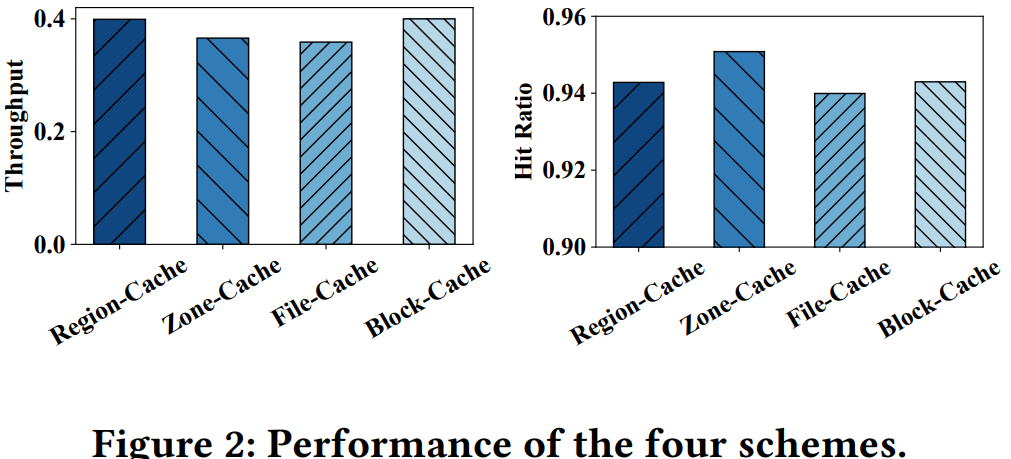Can ZNS SSDs be Better Storage Devices for Persistent Cache?
| Venue | Category |
|---|---|
| HotStorage'24 | ZNS SSDs, Cache |
Can ZNS SSDs be Better Storage Devices for Persistent Cache?1. SummaryMotivation of this paperZNS SSDs in Persistent CacheImplementation and Evaluation2. Strength (Contributions of the paper)3. Weakness (Limitations of the paper)4. Some Insights (Future work)
1. Summary
Motivation of this paper
motivation
existing works mainly focus on cache data on block-based regular SSDs
widely used as storage backends for persistent cache
caching workload are write- and update-intensive with high capacity utilization
incurs a large amount of device-level write amplification (WA)
with many random and small writes to SSDs
internal garbage collection (GC)
SSD lifespan and performance issues
ZNS SSDs
two advantages
need much lower internal over-provisioning --> larger capacity
a better overall cache hit ratio
new interfaces --> potential to reduce WA
problem
explore three possible schemes to adapt the existing persistent cache system on ZNS SSDs
utilize CacheLib as a general cache framework
ZNS SSDs in Persistent Cache
three possible schemes

File-Cache
run CacheLib on a ZNS-compatible file system (F2FS)
FS handle all low-level operations management
Zone-Cache
directly maps the cache on-disk management unit (i.e., region) to the fixed-size zone
achieve true zero WA and be GC-free
Region-Cache
a simple middle layer to translate the zone interface to the region interface
needs GC to clean the zones
File-Cache
ZNS SSD can be formatted with a compatible file system
zone allocation, zone cleaning with GC, and indexing handled by FS
fully transparent to CacheLib
treat ZNS SSD like a regular device
bad
feasible and convenient, but will bring explicitly high overhead
Zone-Cache
most of the persistent cache designs
group the newly inserted cache objects into a much larger management unit (fixed-size regions)
reduce WA and improve IO efficiency --> allocating and evicting large IO units
enlarge the region size to match the zone size
one region per zone
when a region is evicted, the zone can be directly reset without any data migration
real zero WA
GC-free
no OP is needed for GC
no extra indexing
adding one entry of zone number to the region metadata for IOs
bad
need to match the region to a large zone size (1077MiB in Western Digital ZNS SSD)
evicting a large region --> cause many valid or hot cache objects to be evicted
impact the hit ratio
need a larger region buffer in memory to cache the newly inserted objects
more DRAM space
long allocation time in eviction and a long filling time in insertion
reducing the parallelism effectiveness
Region-Cache
add a simple middle layer to translate region to physical zone addresses
data management
region ID --> in-zone addresses
bitmap indicates whether the region is valid in zone
1024 MiB Zone --> 16MiB region
GC
use a background thread to check the empty zone number and valid data size
GC threshold and the zone selection threshold are configurable
depends on the workloads
opens the design space to further optimize the throughput and WA
co-design between cache management and zone management
Implementation and Evaluation
evaluation
setting
flexibility, space efficiency, performance, and WA
compared with CacheLib on regular SSDs (Block-Cache)
ZNS SSDs
Western Digital Ultrastar DC ZN540 with 904 zones the zone size is 1077MiB
regular SSD
1TiB SN540 SSD
overall comparison

Zone-Cache has the largest cache size (no OP) --> highest cache hit ratio
different OP ratio
tradeoff between throughput and hit ratio
higher WA --> lower throughput
end-to-end evaluation with RocksDB
throughput: Region-Cache is highest, Zone-Cache is lowest
ZNS SSDs can give a larger cache size than regular SSDs
2. Strength (Contributions of the paper)
ZNS SSDs persistent cache can reduce the tail latency and lower WA compared with regular SSDs
ZNS SSDs can be better storage devices for persistent cache
Zone-Cache can perform better in the hit ratio
Region-Cache can perform better in throughput
3. Weakness (Limitations of the paper)
4. Some Insights (Future work)
open-channel SSDs
separate different data streams into different channels
relieving WA and GC penalties
zone-based storage
sequential write and zone-based cleaning constraints
avoid internal GC
GC task can be managed by the applications
write pointer
shift to the start by zone reset
jump to the end of the zone by zone finish
CacheLib
a pluggable caching engine developed by Meta
log-structured cache
flash space is partitioned into regions
each region is used to package cache objects with different sizes
evict entire regions rather than individual cache objects
region size is configurable, e.g., 16MiB
are designed to use either
a raw regular block device
one large file allocated in a file system (pre-allocated file)